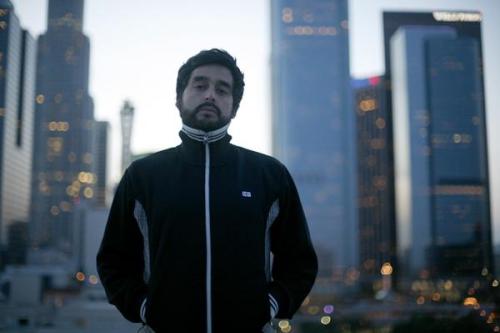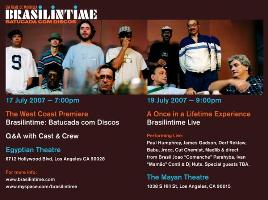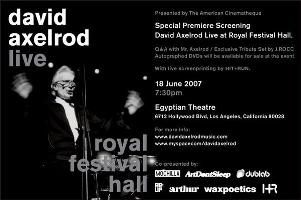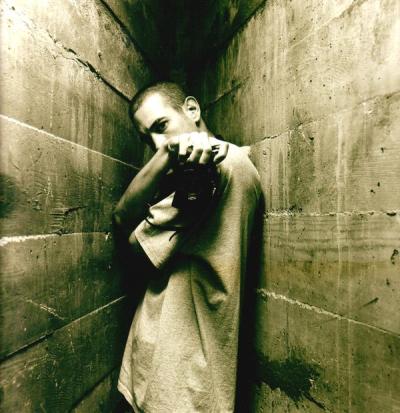
Andrew Lojero and the L.A. skyline. Photo by Theo Jemison.
Some compilations just collect tracks that fit into a genre; others introduce a brand name. From L.A. with Love exposes a West Coast movement. Its 17 tracks hail from well-known underground musicians such as Madlib (as Sound Directions and Yesterdays New Quintet), Georgia Anne Muldrow, Flying Lotus, Free Moral Agents, Carlos Niño (from AmmonContact, Hu Vibrational and other projects) and DJ Exile. Famous visual artists like B+ (the photographer/filmmaker famous for his work with DJ Shadow and the documentary Keepintime), HVW8 and Kozyndan interpret the songs with imagistic paintings and photographs. The CD package, from its color booklet to its colorful songs, exposes a criminally-unsung scene bursting with creativity.
Andrew “Plandru†Lojero is the man who conceived From L.A. with Love. A lifelong Los Angeleno raised in Boyle Heights, Lojero first made his name as part of Prima Lux, an event promotions team that also included Pablo like Picasso and the late Tarek “DJ Dusk†Captan. He soon launched his own imprint, ArtDontSleep, and began throwing off-the-map parties at warehouses and under bridges.
I’ve never been to an ArtDontSleep party. But that’s what so unique about From L.A. with Love. It communicates the adventurousness of L.A.’s underground music scene, and makes it vivid for anyone who cares to purchase the CD.
My conversation with Lojero began after he reached out to me via email this spring, a few months before the compilation’s release on June 5. I used a press release on the album to write a short preview. Somehow, he found the preview and generously added a link to his newsletter and MySpace bulletin blasts, resulting in hundreds of new viewers for Plug One. After he contacted me via email, I agreed to interview him about From L.A. with Love. This interview took place in mid-May.
A brief warning: unlike some of the past profiles I’ve written for Plug One, Lojero isn’t a known personality. Much of our dialogue can be categorized as “inside baseball,†and refers to events, venues, promoters, labels and artists that most people – even hip-hop heads – may have never heard of. I’ve added dozens of links to proper names mentioned in order to facilitate translation. Click on the links and educate yourself.
Some of the events Lojero has co-promoted include (left) a premiere party for the Brasilintime DVD and a David Axelrod screening


Plug One: Let’s start at the beginning. What do you do?
Andrew Lojero: I run a very grassroots-oriented company called ArtDontSleep, and for the last two years we’ve been doing nothing but illegal, beautiful, varied events in locations throughout downtown Los Angeles. This year we’ve been focusing much more on formal institutions and museums and Egyptian Theatre, Mayan Theater-esque venues. We’re really doing our best to create and curate positive events.
Plug One: Can you name some of the venues and specific events that you’ve held?
Andrew Lojero: I just finished a party last Friday [May 12] at something called the Bedlam art warehouse, a really beautiful, 20,000 square foot warehouse/gallery space in downtown L.A. Another spot that I used – I don’t exactly want to give the address or the location – but I used a special rooftop for two years in a row in a beautiful place in downtown L.A. with the skyline behind us, maybe 20 floors up.
Plug One: What parties did you have at the Bedlam Art warehouse and at the rooftop?
Andrew Lojero: At the Bedlam Arts warehouse I did a party with Nickodemus and Federico Aubele from ESL. A year prior, I did a party with DJ Dusk, who was my partner on that project, and Peanut Butter Wolf, J-Rocc, Cut Chemist, and this very particular, peculiar cat named Andy Votel from B-Music out in London. That was his first time ever coming out to L.A.
On the rooftop events, I rocked a party with Cut Chemist, J-Rocc, this cat named Nobody, and a couple of other locals.
Plug One: When people think of a music scene, they usually think of the musicians, the DJs, and producers who make up that scene. What does a promoter like you add to a music and arts scene? What do the events add to a music and arts scene?
Andrew Lojero: L.A. is definitely bubbling right now. L.A. is really a hotbed for anything leftfield in music. So there’s already this amazing fabric of creativity taking place here.
But what someone like me adds to this scene is a variety of abnormal occurrences, if you will. I rarely use the same venue twice, and I try my best to embed my lineup with as many different folks in the city as possible. The crowd that turns out to my event is more of a daring adventurous crowd than you would catch in your normal spots. My spots never really have that tough security because everybody moderates themselves, and everybody is really there to build and take it to that next higher level.
Let me throw out the Chaplain House, too. We really had some beautiful parties at the Chaplain House.
Plug One: What makes the Los Angeles scene special from what you’ll find in New York, San Francisco or Chicago, for example?
Andrew Lojero: I can’t speak so much on Chicago, as I haven’t found the right channels to properly study it. But I can speak on San Francisco, as I’ve done a few events there.
First off, San Francisco is a small place. It’s, like, 7 by 7 miles. So everybody there knows everybody there in a very real way. In San Francisco, it’s become much more monotonous – and L.A. was definitely like this two, three years ago – where it’s just the same cats doing the same thing in the same venues, and not really branching out or trying to reach that next level.
New York is a different beast. New York, in a lot of ways, sets its own standard, and I don’t really hear too much about promoters taking it to that next level. There are two special promoters out there. One of them is named Mahssa. She does some very peculiar, obscure late night gatherings in very rare spaces. The other one is named Miss Nelch. She runs with the hip-hop heavyweights: Pete Rock, Waajeed, Spinna, Bobbito, and Hank Shocklee.
L.A. is on its own turf, in the sense that L.A. the only one out of those three cities that you mentioned that isn’t afraid to finally start the deep experimenting, and trying to reach new heights of real culture; whereas everybody else seems to be on a very systematic and formulaic expression of night, know what I mean? L.A. is definitely seeking to expand upon what it already has.
Plug One: It’s ironic that you’re saying this, because historically Los Angeles has had a reputation of being very shallow and very concerned about money and image. But you’re saying that the scene that you travel in is actually the deepest?
Andrew Lojero: I would say that, yeah, our unsung roots spread real deep. There’s only a certain amount of light that each city is going to get, and it’s unfortunate that L.A.’s light gets taken up by a bunch of half-rate creatives that extend that same portrayal of Los Angeles instead of showing a deeper side that we all reside in. This thing runs deep. Cats like Dublab.com, the crew that Garth Trinidad runs with [Chocolate City], the Root Down sound system, the Art Don’t Sleep parties, and the Umoja Sound System – all these crews have been really doing this for the last 10 years.
I’m the new one in all this. And they’ve been grinding it out so heavy that it allowed room for a cat like me to pop up. If it weren’t for those people laying down the roots for the last 10 years, then I would not exist, know what I mean?
Plug One: How long have you been doing parties?
Andrew Lojero: Uh, three years now. It started with art shows, and then it led to underground [parties], and now it’s turning into a real grand acceptance by all the major institutions that really want to see some fresh, new, innovative ideas.
Plug One: Who are some of the major institutions that you’ve worked with? I know you named some warehouses and some smaller places where you’ve done things.
Andrew Lojero: As far as where I’ve worked, there’s the Natural History Museum, and that’s pretty much it. As far as what I have coming up in the summer, I’m working with the Egyptian Theater, the Mayan Theater, the Architecture and Design Museum, the LACMA (Los Angeles County Museum of Art), and the Disney Concert Hall. So I’m working my way through all the ranks. The goal is to also pull in the Getty Museum, the MOCA (Museum of Contemporary Art), the Hammer Museum, and the Bergamot Station. By next year, we – as in me, a different crew named Mochilla (B+ and Eric Coleman) and Dublab – will have definitely conquered all the major institutions in Los Angeles.
Some of the musicians and artists on From L.A. with Love: Madlib and B+ … Georgia Anne Muldrow and Jim Mahfood …


The late Tarek “DJ Dusk” Captan, who Lojero calls “the essence of Los Angeles.”
Plug One: Why do you think the Los Angeles scene hasn’t gotten as much attention as some of the emerging cultures that have come out of other cities?
Andrew Lojero: Like I was saying, sometimes the media doesn’t really like to experiment on something new. They shine a light on the same stale creativity that’s out there. I’m really disappointed with a lot of people that are so enthused with cats like Steve Aoki, DJ AM and all those top 40 DJs that don’t really know the culture behind being a DJ and making people dance, smile, love, and enjoy themselves.
Plug One: Yeah…right now, Los Angeles is more known for the party rock scene: iHeartcomix …
Andrew Lojero: Exactly.
Plug One: And you’re not feeling that?
Andrew Lojero: Yeah, I’m not feeling it, either.
Plug One: No…I’m asking if you’re not feeling it. I haven’t been to those parties…
Andrew Lojero: [laughs] Don’t front on me, Mosi! I know you ain’t feeling it, either!
Plug One: I mean, I can’t say! For me, everything has its place. Sometimes I can get into that whole scene. But I’m asking your opinion because, living in Los Angeles, you know it much more intimately than I do.
Andrew Lojero: You’re right. That whole scene has its place, and I just don’t feel like that place is the cover of URB and all these magazines. [These magazines] should be focusing on culture-driven issues. It just seems that people that wear funny clothes get attention on a musical tip, [even though] their music really suffers [from a lack of] any kind of integrity whatsoever. But people who put their heart and soul into the integrity of their music aren’t getting the shine that they deserve.
I could name off countless people for days that really do deserve some gorgeous spotlight. In L.A., there’s so much creativity bubbling here that it’s amazing to me how all this stuff gets passed up and overlooked.
Plug One: I think Stones Throw is the exception. Would you agree?
Andrew Lojero: Yeah, of course. Stones Throw is definitely the exception, and thank god that they shine that beacon of light.
Plug One: Before we get into the compilation, can you talk about DJ Dusk a little bit? I don’t think people outside of California realize how important he is to the music scene there.
Andrew Lojero: Dusk has definitely become an icon. He’s one of those few people that – while he was alive – everyone loved and revered. Now, with his passing, everyone is still in great mourning. I feel like a lot of people out here in L.A. are just starting to understand and grasp that he’s not with us anymore. ‘Cause it feels like he still is, you know what I mean?
The importance of Dusk to the whole music community at large in Los Angeles…Dusk was the first DJ to start throwing any kind of Latin joints in his sets, and to take a funk and soul crowd and really make them salsa.
And Dusk was the MC on the mic that will always let you know that you’re not alone in your political beliefs and in your quest in life. It’s amazing: Every night at the Root Down – he was one of the Root Down DJs for the last seven years and he helped found the Root Down – he’d ask the crowd if he could get a finger for George Bush. The whole crowd would go wild and get in on some “fuck Bush†shit. It’s just one small example of what Dusk [represented] for all of us.
Even though he wasn’t a native, he was the essence of Los Angeles. If anybody asks why I only put a ten-second interlude of Dusk on [From L.A. with Love], it’s really because that’s all I needed to capture that essence.
Plug One: Where is DJ Dusk from originally?
Andrew Lojero: He was born in West Africa, moved to New York, and from New York moved to Los Angeles at a really young age. So he was here the majority of his life.
Plug One: How did he pass away?
Andrew Lojero: He was struck down by a drunk driver while he was crossing the street. Instead of moving out of the way, he pushed this girl out the way so she could survive the hit. He took the majority of the impact.
… Nathan Yell (Aloe Blacc) and Azul 213 … Blank Blue (Nobody and Niki Randa) and Blaine Fontana …

Plug One: Let’s get into the compilation. What is From L.A. with Love about?
Andrew Lojero: From L.A. with Love is about putting the scene out there that we all dwell in, putting out the creative circles that we all live in, and presenting it in the most humble manner possible for the rest of the world to experience.
Plug One: Can you tell me a little bit about how you went about putting together this compilation?
Andrew Lojero: A couple of the executives from Milan used to come out to the parties. They approached me about a couple of the artists. In turn, I proposed the idea of the comp to them. They really liked it. So, in a lot of senses, here we are.
Plug One: Did you have trouble securing any of the tracks, particularly from Madlib, DJ Exile and some of the more well-known producers on the album?
Andrew Lojero: Madlib is definitely a trippy dude. Everything you hear about him is true. He’s very, very, very difficult to get a hold of. It went down to the wire.
The most difficult person to get a track from, specifically because he’s so self-conscious is the Gaslamp Killer. It came down to 10 minutes before I had to mix in his track when he turned it in.
Plug One: The music is very esoteric-sounding. I was surprised at how eccentric the compilation sounds. Even now, there’s a sound that’s associated with that scene, which is very blissed-out and glitchy-sounding hip-hop. But the compilation is actually very weird.
Andrew Lojero: [laughs] I have to say that, if any of that is true, it’s my weirdness coming out, my esotericness [sic], and my eccentricity coming through.
Each one of these cats has such a strong, wide palette. Everybody on this comp is super eclectic. This is just what I personally dig, and my presentation of what’s taking place in L.A. right now. So if it’s melancholic, moody and dramatic at points, that’s my unfortunate or fortunate eccentricities popping through.
Plug One: When you selected these tracks, was it a matter of you, say, going to a producer like Daedelus & Adventure Time, and them giving you a range of tracks to choose from and you picking out a certain track? Or did they come to you with a specific track they wanted you to use?
Andrew Lojero: Each one of these cats is good friends of mine. It was a lot more casual than you would imagine, and very formal-free. It was me sitting down in their studios and listening to – at least for some of these cats – everything in their archive, and me finding what suited the comp the best.
What I didn’t discriminate on was the artwork. I didn’t discriminate on what was turned in visually, because I thought if I’m really going to let them interpret it, I have to give them the freedom to do that.
Plug One: There are a couple of debuts on here, right, such as Blank Blue and Nathan Yell.
Andrew Lojero: With Nathan Yell, a lot of people don’t realize that [his song “Goodbyeâ€] is nothing but a cappella and hands. There’s no instrumentation on that thing whatsoever. It’s all based on sounds coming from his hands or his mouth.
Plug One: What are some of the other things that people can anticipate with this album? For those that haven’t heard the record, what can they look forward to?
Andrew Lojero: Each track, at some point, touched me. Living in L.A., I listen to all my music in the whip. That’s where my entire decision making took place, that’s where all of my vibing took place, and that’s where I either hated or loved a track. I try to choose music that will fit any surrounding that you’re in. If you’re on a subway, if you’re jumping in the shower, if you’re riding in the whip, or if you’re in a club, I think a lot of these tracks can get down in any environment.
Plug One: Very quickly, can you get into some of the artwork that’s featured on the compilation?
Andrew Lojero: The artwork featured on the compilation is all from beautiful L.A. cats that took the track given to them and created something visually inspired from it. A lot of the collaborations with people such as Retna, Dez Einswell, Kozyndan, Blaine Fontana and B+ — these are all people that are revered internationally, but are humble enough to get down on this. It’s something to look forward to when you purchase the comp.
I feel like, with 90-95 percent of music that gets thrown out there, the people putting out the music forget that music is not only about the sounds you here but also about the packaging experience that comes with it. Part of the reason why the music industry is suffering so badly is that people can burn something and not miss anything from not buying it. Whereas if you burn From L.A. with Love you’re missing 50 percent, if not more, of the magic and essence that goes with this material.
In particular, there’s this one cat, who isn’t a visual artist or a musician but a poet that wrote a piece on Los Angeles. It’s called “Evolution to Becoming a Megalopolis,†and his name is Mike the Poet. So there are all kinds of goodies in this package that shouldn’t be missed.
Plug One: Do you consider yourself a booster for Los Angeles?
Andrew Lojero: I like the word catalyst. I definitely consider myself a catalyst. I see that it was all there [already], and I just added a formula to it so that it could move in the direction that it needed to move. It’s amazing to me how easy everybody was in working with them to turn this compilation from a dream to a reality.

… Flying Lotus and Dez Einswell … DJ Exile and Retna


you are my uncle, i really am your nefiu
by the way if you get this message it is for Andrew from your nefiu